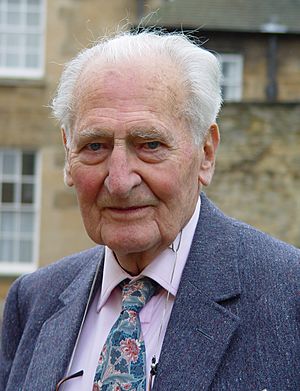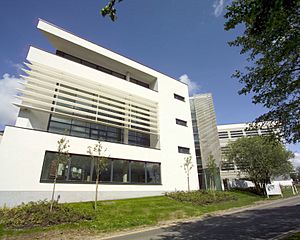Richard Doll facts for kids
Quick facts for kids
Richard Doll
|
|
|---|---|

Richard Doll in 2002
|
|
| Born |
William Richard Shaboe Doll
28 October 1912 |
| Died | 24 July 2005 (aged 92) Oxford, England
|
| Alma mater | King's College London |
| Known for | Epidemiology of smoking Armitage–Doll model |
| Awards | Gairdner Foundation International Award (1970) Buchanan Medal (1972) Charles S. Mott Prize (1979) Royal Medal (1986) Prince Mahidol Award (1992) Shaw Prize (2004) Gold Medal for Radiation Protection (2004) King Faisal International Prize (2005) |
| Scientific career | |
| Fields | Physiology Epidemiology |
| Influenced | Louise A. Brinton Julian Peto Richard Peto |
Sir Richard Doll was a British doctor and scientist. He became famous for his important work in epidemiology. Epidemiology is the study of how diseases spread and what causes them in large groups of people.
Sir Richard Doll was a pioneer in showing the link between smoking and serious health problems. Along with other scientists, he was one of the first to prove that smoking greatly increases the risk of lung cancer and heart disease. His research changed how people thought about smoking and health around the world.
He also did important work on how radiation can lead to leukaemia (a type of cancer). He studied the connection between asbestos and lung cancer, and between alcohol and breast cancer.
Contents
Early Life and Education
Richard Doll was born in Hampton, London, in 1912. His father was a doctor, but he became ill. Richard first wanted to study math at Trinity College, Cambridge, but he didn't get a scholarship.
So, he decided to study medicine instead. He went to St Thomas's Hospital Medical School at King's College London and became a doctor in 1937. Richard Doll believed in social equality. He was part of a group that helped create Britain's National Health Service. This service provides healthcare for everyone.
During World War II, he served as a medical specialist in the Royal Army Medical Corps. He worked on a hospital ship, helping injured soldiers.
Groundbreaking Research
After the war, Doll started researching asthma. In 1948, he joined a research team at the Central Middlesex Hospital. This team was part of the Medical Research Council. He eventually became the director of this research unit.
His early work looked at how jobs might cause peptic ulcers. But his most famous work began in 1950. He teamed up with Austin Bradford Hill to study lung cancer patients in London. At first, they thought things like new road materials or car fumes might be the cause. But they quickly found that tobacco smoking was the only common factor among the patients.
Doll himself stopped smoking because of what he discovered. Their findings were published in a medical journal in 1950. They showed that:
The risk of developing the disease increases in proportion to the amount smoked. It may be 50 times as great among those who smoke 25 or more cigarettes a day as among non-smokers.
Four years later, in 1954, they did a bigger study called the British doctors study. They followed about 40,000 doctors for 20 years. This study strongly confirmed the link between smoking and lung cancer. Because of this, the government officially warned people about the dangers of smoking. In 1955, Doll also showed a clear link between asbestos and lung cancer.
Later Career and Honors
In 1966, Richard Doll was chosen to be a member of the Royal Society. This is a very important group of scientists. The Royal Society recognized his work on cancer, especially lung cancer from smoking and industrial causes. They also noted his research on leukaemia caused by radiation.
In 1969, Doll moved to Oxford University. He became a top professor there, called the Regius Professor of Medicine. At that time, the study of epidemiology was not very popular. But Doll helped make it a respected field. He was also key in starting Green College, Oxford in 1979. He became its first leader.
Doll also helped create the National Blood Service in the UK. He made sure that blood donors were not paid. This helped keep the blood supply safe and fair. He continued his research on things that cause cancer (called carcinogens). Working with Richard Peto, he estimated that tobacco, infections, and diet caused about three-quarters of all cancers. This research helped the World Health Organization understand how our environment affects cancer.
Sir Richard Doll received many awards for his work. He was made a knight in 1971, which means he was called "Sir." In 1996, he was given the Companion of Honour award for his important national contributions. He also received many international awards, including the Shaw Prize for Life Sciences and Medicine in 2004.
Death and Legacy
Sir Richard Doll passed away on July 24, 2005, in Oxford. He was 92 years old.
A special blue plaque was placed on his home in Oxford to remember him. Although he grew up in a Jewish family, he was an atheist.
Buildings Named After Him
Two buildings are named in honor of Sir Richard Doll. One is the Richard Doll Building in Oxford. It was designed in 2006 and opened shortly before he died. This building is home to important research units that study cancer and health.
Inside the Richard Doll Building, there is a quote from him. It reminds us that while getting old and dying is natural, dying young often isn't. He believed that for non-smokers in many countries, dying before age 70 is becoming rare. He hoped for a world where early death is uncommon, but stressed the huge harm caused by tobacco. He wanted people to understand how much smoking shortens their lives.
Another building, part of the Institute of Cancer Research in London, is also named after Sir Richard Doll.
See also
- Health effects of tobacco
- Lennox Johnston


